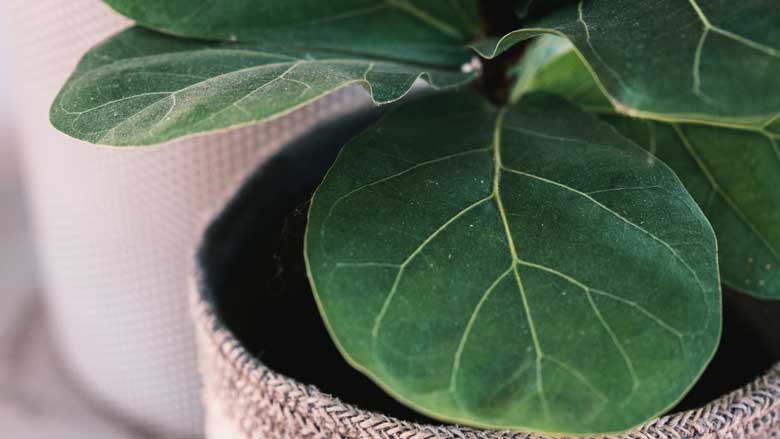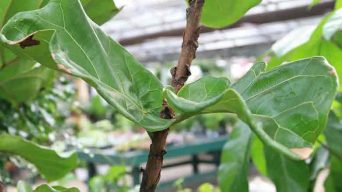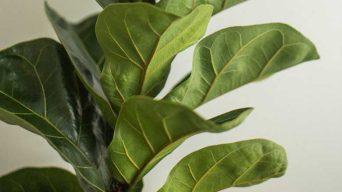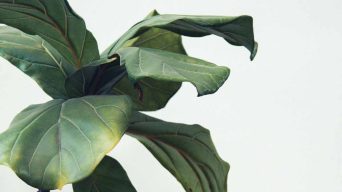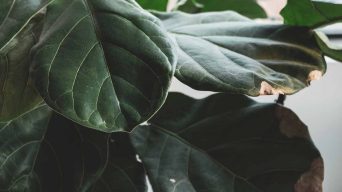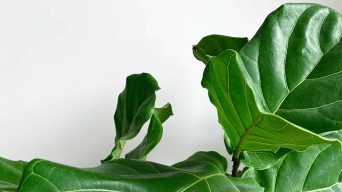White spots on Fiddle Leaf Figs often indicate powdery mildew, sunburn, environmental stress, pests, or mineral deposits. Treat by improving air circulation, relocating the plant, using fungicides or insecticides, and ensuring proper watering and lighting conditions. Regular care helps prevent these issues.
Fiddle Leaf Figs (Ficus lyrata) are a popular type of houseplant known for their large, glossy leaves.
They are native to tropical climates, requiring warm temperatures and high humidity to thrive.
One of the most common problems with Figs is white spots on the leaves.
Here is a quick guide on treating white spots on your Fiddle Leaf Fig.
Identifying Common Causes of White Spots on Fiddle Leaf Figs
Fiddle Leaf Fig plants, while popular, are prone to various issues, such as fungal diseases, pests, and environmental stress.
A frequent concern among caretakers is the appearance of white spots on the plant’s leaves and stems. These spots can arise from multiple sources.
Below, we explore the most prevalent causes of these white spots in Fiddle Leaf Figs:
1. Powdery Mildew
Fiddle Leaf Fig plants are susceptible to several diseases, including root rot, bacterial leaf spot, and powdery mildew.
The most common disease that causes white spots is powdery mildew.
Powdery mildew is a fungal infection that can occur in many houseplants, including Fiddle Leaf Fig plants.
The fungus thrives in humid conditions and produces a white or gray powdery substance on the surface of the leaves.
The first signs of powdery mildew are small, white spots on the leaves.
The spots will become larger as the infection progresses, and the Fiddle Leaf Fig leaves will begin to curl and turn yellow.
Powdery mildew is a severe problem that can eventually kill your Fiddle Leaf Fig plant if untreated.
You can know if your plant has powdery mildew if the leaves have white powder that can easily rub off.
2. Sunburn
Fiddle Leaf Fig plants are native to tropical climates and require bright indirect light to thrive.
However, too much direct sunlight can cause the leaves to develop white spots.
The spots are tiny burns caused by the sun’s rays.
If your Fiddle Leaf Fig plant is in a sunny spot, you may notice that the leaves have developed yellow or brown spots.
These are sunburns and will eventually turn white.
3. Environmental Stress
Fiddle Leaf Fig plants are sensitive to changes in their environment.
The plant may develop white spots on the leaves if the temperature suddenly drops or rises.
Other environmental stressors, such as drafts, can also cause white spots.
You can tell if your plant is experiencing environmental stress if the leaves are wilting or the spots are accompanied by other symptoms, such as yellow leaves.
4. Pests
Fiddle Leaf Fig plants are susceptible to several pests, including mealybugs, scale insects, fungus gnats, and spider mites.
The most common pest that causes white spots is mealybugs.
Mealybugs are tiny, sap-sucking insects that feed on the leaves of plants.
They excrete a sticky substance called honeydew, which can cause sooty mold to grow on the plant.
The first signs of mealybugs are small, white spots on the leaves.
As the infestation progresses, the spots will become larger, and the leaves will begin to yellow and curl.
Mealybugs are a severe problem that can eventually kill your Fiddle Leaf Fig tree if not treated.
5. Mineral Deposits
Fiddle Leaf Fig plants are susceptible to a condition called mineral build-up.
This happens when the leaves are exposed to water that contains high levels of minerals, such as calcium or magnesium.
The minerals build up on the surface of the leaves and cause water spots.
If the spots are hard and crusty, you can tell if your plant has mineral build-up.
Step-by-Step Treatments for White Spots Issues on Fiddle Leaf Fig Leaves
Fiddle Leaf Fig plants with white spots on their leaves are a common but concerning issue for plant lovers.
These spots can signify various problems, such as pest infestations, fungal diseases, or environmental stress. Correctly identifying the cause is crucial for effective treatment.
This guide offers detailed steps to tackle white spot issues on your Fiddle Leaf Fig plants, ensuring their health and vitality.
Treating Powdery Mildew on Fiddle Leaf Fig Leaves
If you think your Fiddle Leaf Fig plant has powdery mildew, it is essential to take action immediately.
Powdery mildew is a severe problem that can kill your plant if not treated.
There are several ways to eliminate powdery mildew on Fiddle Leaf Fig plants.
Here are some of the most effective methods:
1. Improve Air Circulation Around Your Plant
Powdery mildew thrives in humid conditions.
Improving the air circulation around your Fiddle Leaf Fig plant will help to reduce the humidity and make it harder for the fungus to spread.
You can improve the air circulation by placing a fan near your plant or moving it to a well-ventilated area.
2. Remove Infected Leaves
One of the best ways to eliminate powdery mildew is to remove the infected leaves from your Fiddle Leaf Fig plant.
This will help reduce the fungus on your plant and prevent it from spreading.
You can remove the leaves by hand or with pruning shears.
3. Treat Your Plant With a Fungicide
If the problem is severe, you may need to treat your Fiddle Leaf Fig plant with a fungicide.
Several fungicides are available, so choose one specifically designed for powdery mildew.
Follow the instructions on the fungicide carefully and only use it as a last resort.
4. Make a Homemade Fungicide
You can also make your own fungicide with ingredients you probably already have in your kitchen.
One of the most effective homemade fungicides is made with baking soda and water.
Mix together 1 tablespoon of baking soda with 1 quart of water.
Spray the mixture on your Fiddle Leaf Fig plant, covering all infected areas.
Do this once a week until the problem is gone.
Treating Sunburn on Fiddle Leaf Fig Leaves
If you think your Fiddle Leaf Fig has developed sunburn, you can do a few things to help it recover.
1. Move Your Plant to a Shadier Spot
Moving your Fiddle Leaf Fig plant to a shadier spot is the first and most important thing.
Place it in an east-facing window where it will get morning sun but be protected from the harsh afternoon rays.
2. Add a Layer of Protection
You can also help protect your Fiddle Leaf Fig plant from further sun damage by adding a sheer curtain or blind to the window.
This will filter the light and prevent the leaves from getting burned.
3. Give Your Plant Time to Recover
Sunburned leaves will eventually turn white and may even fall off.
This is normal; your Fiddle Leaf Fig plant will eventually grow new leaves.
In the meantime, keep an eye on your plant and water it regularly.
4. Avoid Fertilizing
Fertilizing your Fiddle Leaf Fig plant while recovering from sunburn can do more harm than good.
Wait until the leaves have fully recovered before fertilizing your plant.
5. Water Properly
Watering your plant properly is essential, but it is crucial when your plant is recovering from sunburn.
Be sure to water only when the soil is dry and avoid getting the leaves wet, as this can cause further damage.
Treating Environmental Stress in Fiddle Leaf Fig Plants
If you think your Fiddle Leaf Fig plant is experiencing environmental stress, you can do a few things to help it recover.
1. Remove the Plant From the Stressful Environment
You need to find out what is causing the stress and remove the Fiddle Leaf Fig plant from the source.
If the temperature has dropped suddenly, move the plant to a warmer location.
Move the plant away from the windows or doors if there is a draft.
2. Make Sure the Plant Is Getting Enough Water
Environmental stress can cause the plant to lose water faster than usual.
Ensure the plant gets enough water by checking the potting soil regularly.
The soil should be moist but not soggy.
3. Increase the Humidity Around the Plant
You can increase the humidity by misting the Fiddle Leaf Fig leaves or placing the plant on a pebble tray.
4. Give the Plant Some Time To Recover
After removing the plant from the stressful environment and increasing the humidity, give the plant some time to recover.
Most white spots should start to fade within a few weeks.
5. Prune Off Affected Leaves
If the leaves are severely damaged, you can prune them off.
Use sharp, clean shears, and disinfect them before and after use.
Prune back to a healthy node or leaf.
This will help the plant to focus its energy on new growth.
Treating a Pest Infestation on Fiddle Leaf Fig Plants
If you think your Fiddle Leaf Fig plant has pests, you can do a few things to eliminate them.
1. Isolate the Plant
The first step is to isolate the plant from other houseplants.
This will prevent the pests from spreading.
2. Inspect the Plant Closely
Take a close look at the plant, paying particular attention to the undersides of the leaves.
If you see any small, white bugs, they are probably mealybugs.
3. Use Insecticidal Soap or Neem Oil
You can treat mealybugs with insecticidal soap or neem oil solution.
They are both effective and safe for use on Fiddle Leaf Fig plants.
Use a cotton swab or a soft brush to apply the soap or oil to the bugs.
Be sure to get under the leaves and in all the nooks and crannies where the bugs like to hide.
4. Repeat as Necessary
You may need to treat your plant several times before the bugs are gone.
Be sure to follow the instructions on your insecticidal soap or neem oil.
5. Discard Infested Plant Material
Once you have treated the plant, remove any infested leaves or stems.
Place them in a plastic bag and throw them away.
Do not compost them!
Treating Mineral Build-Up on Fiddle Leaf Fig Plants
Remove the spots with a soft cloth or a toothbrush if your plant has mineral deposits.
Gently rub the spots until they come off.
You can also try using distilled water to water your plant.
This will help to remove any minerals that are in the water.
You can install a water softener if you live in an area with hard water.
This will help to reduce the amount of minerals in your water.
You can also try using rainwater to water your houseplant.
If you don’t have access to rainwater, you can collect water from a dehumidifier.
This will also help to reduce the amount of minerals in your water.
Preventative Measures for Maintaining Healthy Fiddle Leaf Figs
To ensure the health of your Fiddle Leaf Fig plants, it’s crucial to prevent white spot issues fiddle leaf fig.
Here’s how:
1. Preventing Powdery Mildew
The best way to deal with powdery mildew is to prevent it from happening in the first place.
Fungi thrive in humid conditions, so ensuring your plant is not too wet is important.
Water your plant only when the soil is dry, and allow the excess water to drain away.
You should also avoid misting or watering your plant in the evening, as this will increase the humidity around your plant and make it more susceptible to powdery mildew.
In addition, make sure that your plant has enough light.
Fungi love shady, dark conditions, so giving your plant enough light will help prevent fungi growth.
Finally, clean up any fallen leaves or debris from around your plant.
This will help to prevent the spread of fungi and other diseases.
2. Preventing Sunburn
The best way to prevent sunburn on your Fiddle Leaf Fig plant is to give it the right amount of light.
Place it in a spot where it will get bright, indirect sunlight, and protect it from direct sunlight.
You can also help protect your plant by adding a sheer curtain or blind to the window.
This will filter the light and help to prevent sunburn.
3. Preventing Environmental Stress
The best way to prevent environmental stress is to make sure the plant is in a stable environment.
Avoid sudden temperature changes and drafts, and ensure the plant has enough humidity.
You can also help protect your indoor plant by acclimating it slowly to new environments.
For example, if you move the plant to a new location, do it gradually for days or weeks.
This will give the plant time to adjust and help prevent stress.
4. Preventing Pest Infestations
The best way to prevent pests is to keep your plant healthy.
A strong plant is less likely to be attacked by pests.
You can also help to prevent pests by keeping your growing space clean.
Remove any dead leaves or stems, and ensure good air circulation.
You must be especially vigilant when bringing new indoor plants into your growing space.
Inspect them carefully for pests before adding them to your collection.
5. Preventing Mineral Build-Up
The best way to prevent mineral build-up is to use distilled water or rainwater to water your plant.
You can install a water softener if you live in an area with hard water.
This will help to reduce the amount of minerals in your water.
You can also try using a water filter.
This will help to remove some of the minerals from your water.
Another way to prevent mineral build-up is to keep the leaves dry.
Water the soil, not the leaves.
If the leaves get wet, dry them off as soon as possible.
Final Thoughts
A Fiddle Leaf Fig tree (Ficus lyrata) is a beautiful, unique houseplant that can brighten any home.
However, it can be a bit finicky regarding plant care and is susceptible to several problems, including white spots.
Fortunately, you can do a few relatively simple things to treat white spots on your Fiddle Leaf Fig plant.
By following the tips outlined in this article, you should be able to get rid of the problem in no time and keep your Fiddle Leaf Fig looking its best.

